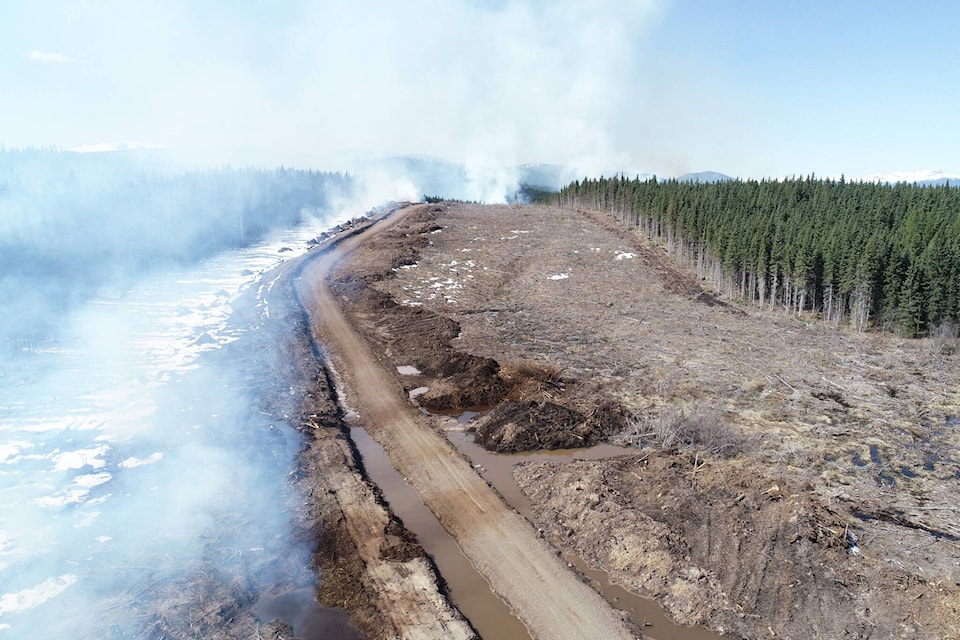The extensive project of the past four years to create a fire fuel break along the Buck Flats Road southwest of Houston is a vital tool when it comes to protecting the community, says a senior official with the provincial agency that provided $1 million to finance the work.
And it has come into sharp focus for Gord Pratt from the Forest Enhancement Society of B.C. who has been keeping an eye on the Peacock Creek fire now burning further south.
“We were very supportive of this project, recognizing the risk of a wildfire coming from the south towards Houston,” said Pratt of the work.
“Mother Nature can through us a whole bunch of curveballs. But what we can do is try and control what we can do to minimize those curveballs,” he added.
“This fuel break is an added tool for our B.C. Wildfire friends.”
For Pratt and others closely connected with the project, memories go back to 1983 when the Swiss fire burned through 18,000 hectares and six residences along the Buck Flats Road.
It began at the north end of Parrott Lake and over the top of Morice Mountain and crossed the Morice River.
Temperatures in the mid-30s and a drop in humidity added to the fire’s intensity and rapid spread.
But it was a wind shift that brought it to the point of being a danger to property and infrastructure.
The prospect of winds from the south and west figured in a 2018 report commissioned by the District of Houston on the risk of wildfires. It recommended the creation of fuel breaks as one way to increase the protection of the community.
Scott Rowsell from Telkwa-based Pro-Tech Forest Resources, the company which managed the fuel break project on behalf of the District of Houston, brought his own perspective to the work.
His dad was a fire boss on the Swiss fire, a suppression effort that involved 500 people and scores of pieces of heavy equipment.
“They had some wind changes and they fought that fire really hard with a lot of equipment,” said Rowsell. “And they managed to stop it where they did and about 17 or 18 kilometres on the Morice road.”
“You can never predict exactly where a fire is going to come from. But this area was identified in the [2018] community wildfire protection plan has moderate to high risk of a wildfire becoming a structure fire.”
Pro-Tech’s management of the fuel break project evolved into a complex effort involving a variety of local and other agencies.
The list includes the Houston Volunteer Fire Department, the District of Houston, the forests ministry, the environment and climate change ministry and the BC Wildfire Service.
The fire fuel break has two components with the first being a fuel-free strip of 150 metres wide on average stretching down 9.7 kilometres of the Buck Flats Road and then a swath of specifically chosen species.
“No trees will ever be allowed to be planed and it will be maintained into the future,” he said of the fuel free zone.
The second component is wider, up to 800 or 900 metres in some locations, and has been planted with 380,000 conifer pine and leafy deciduous birch seedlings.
Pine was chosen because it has what Rowsell called a “low crown density” meaning that compared to other conifer species, there is less of it to burn.
A deciduous forest provides for shady conditions on the forest floor, resulting in the growth of brush. In drought conditions, that brush dries out and creates a fire hazard.
But in choosing both birch and pine, the intent is to have a species mixture that can provide firefighters with an edge to battling a blaze.
“We can have some somewhat of an intact [pine] conifer overstory to limit shade. But then we can break up the canopy with [deciduous] birch to try and slow down a fire,” Rowsell said.
In technical terms, wildfire specialists call a fire that leaps from tree top to tree top a “running crown fire” that spreads so quickly it can outpace attempts at control and presents a safety hazard.
“Birch was chosen over other deciduous species because it is not currently being affected by the Silver Leaf Miner (forest pest) that is affecting the aspen and cottonwood in the area,” said Rowsell.
Before replanting, the area needed to be logged of trees already there, a process that involved getting a provincial cutting licence.
Merchantable wood was sold off to forest companies and pellet manufacturers, wood was made available for fencing and members of the public were encouraged to take what they wanted for firewood.
“We marketed the wood, even the marginalized wood, as much as we could. But in the end, some of it did end up getting burned,” said Rowsell.
Proceeds from the sale of wood helped pay for expenses and profits went to the District of Houston.
Overall, Rowsell described the project as providing a big learning curve because of the complexity of both creating a fire fuel break and replanting a portion with a mixed species.
“I would say 80 per cent was pretty fun and interesting. And 20 per cent of it was incredibly stressful and complicated,” he said.
